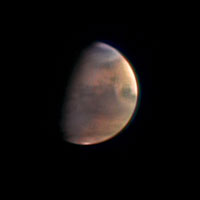 |
||||||
|
Mars current research Ever since time immemorial, people have paid much attention to planet Mars. Astrologers of ancient civilizations were fascinated by the planet’s red colour. In various mythologies, Mars symbolized fire and war.
BIRA-IASB has also been involved since a long time in the remote sensing of planetary atmospheric using spectroscopic methods, as well in the infrared spectral range, as in the ultraviolet range. Analysing spectra of radiation being transmitted through the atmosphere (through processes such as absorption, emission or diffusion) tells a lot on the composition and the structure (temperature and density) of the sounded atmosphere. A particular type of observations, called solar occultations, allows the detailed study of what happens at the terminator, i.e. the limit between the day and night sides of the planet.
|
|||||
